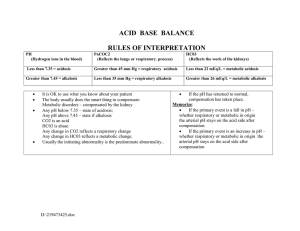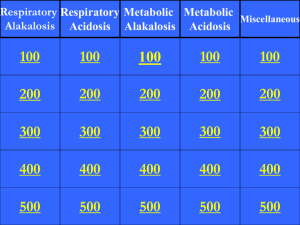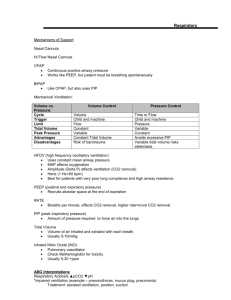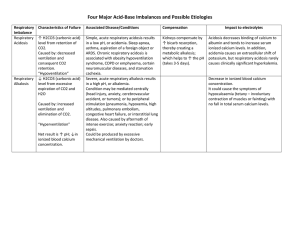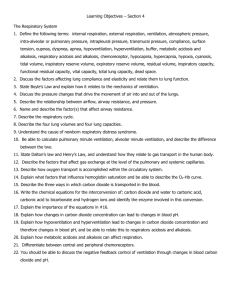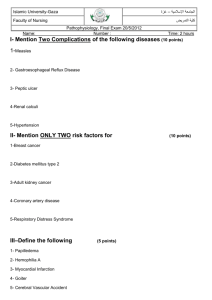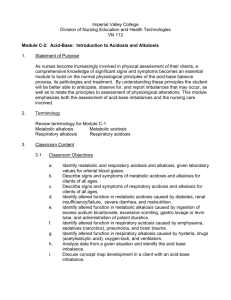Title : Body Fluids
advertisement
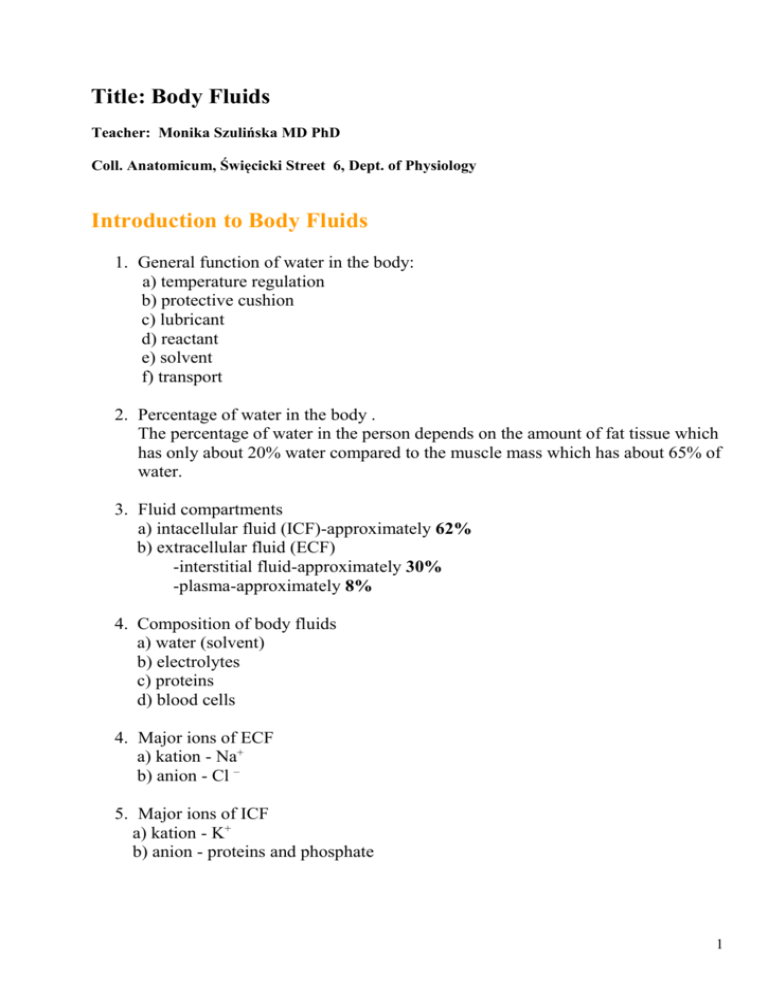
Title: Body Fluids Teacher: Monika Szulińska MD PhD Coll. Anatomicum, Święcicki Street 6, Dept. of Physiology Introduction to Body Fluids 1. General function of water in the body: a) temperature regulation b) protective cushion c) lubricant d) reactant e) solvent f) transport 2. Percentage of water in the body . The percentage of water in the person depends on the amount of fat tissue which has only about 20% water compared to the muscle mass which has about 65% of water. 3. Fluid compartments a) intacellular fluid (ICF)-approximately 62% b) extracellular fluid (ECF) -interstitial fluid-approximately 30% -plasma-approximately 8% 4. Composition of body fluids a) water (solvent) b) electrolytes c) proteins d) blood cells 4. Major ions of ECF a) kation - Na+ b) anion - Cl – 5. Major ions of ICF a) kation - K+ b) anion - proteins and phosphate 1 6. Functions of electrolytes -cofactors for enzymes -action potentials in neurons and muscle cells -secretion and action of hormones and neurotransmitters -muscle contraction -acid/base balance -secondary active transport -osmosis Water Homeostasis 1. Total Body Water ( TBW ) – about 40L -water intake (food and drink - 2300ml; cell metabolism- 200ml; total- 2500) -water output (kidneys – 1500ml; skin- 600ml; lungs- 300ml; GI tract-100ml; total – 2500ml) 2. Disturbances of Water Homeostasis -hypervolemia (infusion of isotonic i.v. fluid) -hypovolemia (blood loss) -overhydration (drinking too much water) -dehydration (sweating) 3. Four Primary Mechanisms Regulate Fluid Homeostasis -ADH -thirst mechanism -aldosterone -sympathetic nervous system Electrolyte homeostasis Na+ and K+ balance are maintained by the kidney through the hormone aldosterone. 1. Roles of sodium in the body (136-145 mEq/L ): - nerve impulse conduction and muscle contraction - regulation of water movement (water follows sodium by osmosis) 2 Hypernatremia (Na+ plasma concentration above 145 mEq/L)-symptoms: nonspecific signs of central nervous system dysfunction such as confusion and lethargy, in severe cases seizure and death. 2. Roles of potassium in the body (3, 5-5, 1 mEq/L): - is responsible for intracellular fluid volume, through osmosis - plays key role in maintaining resting membrane potential, nerve impulse conduction, muscle contraction and maintenance of normal cardiac rhythm. - plays important role in acid / base balance Hypokalemia (K+ plasma concentration bellow 3, 5 mEq/L) cause: decrease neuromuscular excitability, skeletal muscle weakness, cardiac dysrhythmias Sever hypokalemia may cause respiratory arrest. Hyperkalemia (K+ plasma concentration above 5.1 mEq/L) can cause intestine cramps, diarrhea, restlessness, changes in EKG. Sever hyperkalemia cause muscle weakness progressing to paralysis, slowed heart conduction, cardiac arrest. 4. Calcium homeostasis (9, 0-11, 0 mg/dl ) is crucial to normal body function. Even small changes in Ca concentration can be deadly. Ca++ balance is maintained by PTH, clcitonin and vitamin D. Hypercalcemia (plasma Ca++ concentration above 11, 0 ml/dl) leads to heart dysrhythmias, fatigue, confusion, coma, cardiac arrest, calcification of soft tissue Hypocalcemia (Ca++ concentration below 9, 0 mg/dl) leads to muscle spasm. When the Ca++ level is very low a person can go into tetanus and breathing will stop. Acid/Base Homeostasis 1. pH of body fluids: -arterial blood - pH 7,35-7, 45 -venous blood - pH 7, 35 -intracellular fluid-pH 7, 0 -gastric juice - pH 2, 0 -small intestine juice - pH 8, 0 -urine- pH 4, 5-8 ,0 based on diet and metabolic state 3 2. The body has 3 ways of maintaining a normal pH range: -chemical buffer system (acts within seconds) a) carbonic acid / bicarbonate b) phosphate buffer c) protein buffer -respiratory controls a) acts within minutes b) important in compensating for metabolic acidosis or alkalosis c) permits elimination of the volatile acid ( bicarbonate acid ) -renal mechanisms a) acts within hours or days b) compensate for respiratory acidosis or alkalosis c) eliminate fixed acids from the body (metabolic acids generated in the body that are eliminated only in the urine). Definitions The Base Excess (-2, 5 ÷ +2, 5 mmol/l) the amount of acid (in mmol) required to restore 1 later of blood to its normal pH, at a pCO2 of 5.3kPa (40mmHg). The Standard Bicarbonate (22-26 mmol/l)is the bicarbonate concentration of a sample when the pCO2 has been adjusted (or ‘standardised’) to 40 mmHg at a temperature of 37C. Blood gas norms pH pCO2 pO2 BE HCO3 7,35-7,45 35-45 mm Hg 80-100 mm Hg -2,5 ÷ +2,5 mmol/l - 22-26 mmol/l 4 pH-bicarbonate diagram help you to identify type of acid-base disturbance. H+ (nmol/l) Metabolic alkalosis Acute respiratory acidosis Acute respiratory alkalosis PCO2(mmHg) HCO3- (mmol/L) Chronic respiratory acidosis Chronic respiratory alkalosis Metabolic acidosis pH Acid Base disturbances 1. Respiratory acidosis (↓ pH & ↑ pCO2 ) -impaired gas exchange ( COLD - chronic obstructive lung diseases, severe asthma, pneumothorax) - impaired activity of diaphragm muscle ( spinal cord trauma, nerve injury) - impaired respiratory control in the brain stem (brain injury, stroke) 2. Respiratory alkalosis (↑ pH & ↓ pCO2 ) - hyperventilation - high altitude 5 3. Metabolic acidosis (↓ pH & negative BE) a) excess acid production -diabetic ketoacidosis -starvation ketosis -lactic acidosis ( intensive exercise) -kidney disease -hyperkalemia b) loss of bases -diarrhea -excessive vomiting 4.Metabolic alkalosis (↑ pH & positive BE) a) loss of acids - vomiting of stomach contents -hypokalemia b) to much bases -ingesting too much HCO3 - Interpretation of Acid Base Disturbance-see page down 6 Interpretation of Acid Base Disturbance pH PCO2 Base excess Positive (>+2,5) pH Primary Respiratory Acidosis Negative <-2,5 Mixed Respiratory & Metabolic Acidosis Norma (4,5-6 KPa) Negative <-2,5 Primary Metabolic Acidosis Low (<4,5 KPa) Negative <-2,5 Primary Metabolic Acidosis with Respiratory Compensation PCO2 High (> 6KPa) Alkalaemia High pH (> 7,45) Primary Respiratory Acidosis with Renal Compensation Normal -2,5 +2,5 High (> 6KPa) Acidemia Low pH (< 7,35) Interpretation Norma (4,5-6 KPa) Low (<4,5 KPa) Base excess Positive (>+2,5) Interpretation Primary Mteabolic Alkalosis With Respiratory Compensation Positive (>+2,5) Primary Mteabolic Alkalosis Positive (>+2,5) Mixed Respiratory & Mteabolic Alkalosis Normal Negative <-2,5 Primary Respiratory Alkalosis Primary Metabolic Alkalosis with Renal Compensation Key 4,5 kPa = 34 mmHg 6,0 kPa = 45 mmHg 7 8
